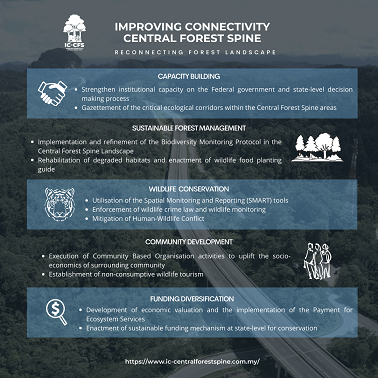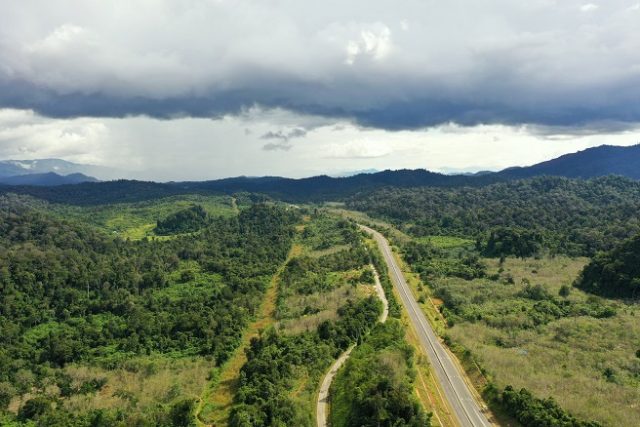IC-CFS continues to support the conservation of the Central Forest Spine with the realignment of plans for 2022
KUALA LUMPUR, 23 June, 2022 — The Improving Connectivity in the Central Forest Spine (IC-CFS) Project, a collaborative effort between the Global Environment Facility (GEF), United Nations Development Programme (UNDP), and the Malaysian Government to conserve biodiversity and ecosystem services in three critical landscapes of the Central Forest Spine, will be realigned bringing forth prioritised strategies and elaborate plans for 2022 in its efforts to sustainably manage Malaysia’s forests.
Spanning over 6.71 million hectares across Peninsular Malaysia, the Central Forest Spine acts as the green backbone to Peninsular Malaysia’s environmentally sensitive area network, comprising eight major forest complexes and 40 ecological corridors spreading across eight states within Peninsular Malaysia including Perak, Pahang, and Johor which are the focus areas of the IC-CFS Project.
In 2021, the Project centred on supporting efforts on increasing enforcement at the state and federal levels to reduce poaching and various other wildlife and forestry crimes that seriously threaten biodiversity including the iconic Malayan Tiger. The habitats of wildlife within the CFS are also enhanced, with the gazettement of 23,734.63 hectares of critical forest areas as Permanent Reserved Forests within the three states. To ensure that the ecological corridors connecting the fragmented forest landscapes are wisely managed to protect biodiversity, Management Plans are being developed. Currently, one has been developed for the ecological corridor at Panti – Ulu Sedili Reserved Forests in Johor.
With the continuation of the IC-CFS Project, additional areas for gazettement are being explored. The monitoring tools for biodiversity, ecosystem service provisions and carbon stocks will be piloted in selected states along with the Management Plans for ecological corridors in the remaining two states of Perak and Pahang. A major target for 2022 will be the development of a Sustainable Finance Plan in Pahang which hopes to identify new sources of income from forest ecosystems services that could see greater income to the states while also better protecting the forest resources and biodiversity.
“The forest can be managed sustainably to enhance the protection of its ecology and biodiversity while sustaining economic benefits and livelihoods. This will be demonstrated through the IC-CFS Project in reducing wildlife and forestry crimes, safeguarding and expanding forest ecosystems, forest rehabilitation and restoration programs, and developing a pragmatic financial plan for the state. These management planning significantly benefits forest habitats while promoting carbon sequestration, which is in line with Malaysia’s stand at the United Nations Climate Change Conference (COP 26), to support the reduction of greenhouse gas (GHG) by 2050,” said Dato’ Hj. Zahari Ibrahim, the National Project Director of the IC-CFS project.
In acknowledgment of the need to reconnect the major forest landscapes, more integrated planning will be undertaken with key agencies such as the Department of Wildlife and National Parks (DWNP), Forest Research Institute Malaysia and the State Forestry Departments of Perak, Pahang, and Johor. Following the successful piloting of the Spatial Monitoring and Reporting Tool (SMART) Patrolling system in 2021 by the Perak State Forestry Department and DWNP, the State Forestry Departments of Pahang and Johor will complete the training and fieldwork this year before the full integration of SMART into Forestry monitoring. This continuation of wildlife monitoring efforts to enhance the protection of wildlife and their habitat will be further strengthened through a novel effort to empower selected Forestry and State Park officers under the Wildlife Conservation Act of 2010. This will enhance the enforcement officers’ capacity to act on wildlife crimes occurring outside of their current jurisdiction.
According to Dr. Samsudin Musa, the IC-CFS’ Project Manager, in a bid to prevent poaching which poses a serious threat to wildlife conservation, community-based enforcement efforts have been developed through Local Community Rangers (LCR). The LCRs comprise Orang Asli hired and trained to undertake wildlife monitoring. To ensure continuity, the LCR will be assimilated as part of the Malaysian Armed Forces Veterans and Orang Asli (VetOA) programme managed by DWNP.
Through long-term commitment by GEF and UNDP and with the financial support amounting to RM 8 Million for the IC-CFS Project this year, the project is given the liberty of expanding its conservation and rehabilitation efforts for the CFS landscape in line with the second thrust of the National Physical Plan 3 that focuses on environmental, land use, and infrastructure aspects.

About Improving Connectivity: Central Forest Spine (IC-CFS)
The Improving Connectivity in the Central Forest Spine (IC-CFS) is a project seeking to conserve biodiversity and ecosystem services in the priority forest landscapes within the CFS.
Incepted in 2014, the project is led by the Forestry Department of Peninsular Malaysia in collaboration with the Department of Wildlife and National Parks (DWNP) and Forest Research Institute Malaysia (FRIM) with the support of The United Nations Development Programme (UNDP) and the Global Environment Facility (GEF) grant.
The main objective of IC-CFS is to strengthen the federal and state capacity in executing the CFS Master Plan to enhance forest connectivity and law enforcement against wildlife and forestry crimes. The project is composed of three components namely planning, compliance monitoring, and enforcement framework for integrated forest landscape management; sustainable forest landscape management of three priority forest landscapes within the CFS; and diversification of financing sources for conservation.












